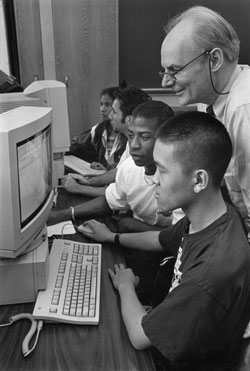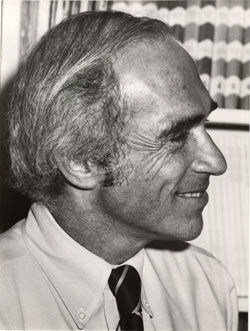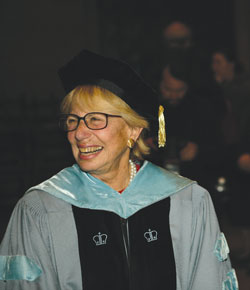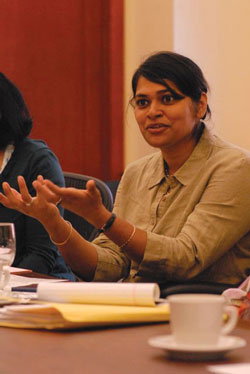Class Will Meet Outside Today
As the pendulum swings toward longer school days and years, is there a future in the concept - long championed at Teachers College - of education that occurs beyond school walls?
By Jonathan Sapers
Some years ago, Lalitha Vasudevan spent the summer knocking around West Philadelphia with a group of fifth-grade boys, ostensibly making a mock horror movie.
Vasudevan, who was working on her Ph.D. at the University of Pennsylvania, had initially planned to write something suitably academic about how her young colleagues saw themselves and how they saw themselves "being seen."
But the boys -'" all of whom were African American and none of whom, as she puts it, "viewed school as a place of belonging" -'" had other ideas. As they experimented with video cameras and recorded the stories of their lives, "very quickly my dissertation became about the kinds of literacy practices that were happening, what kinds of artifacts were being produced," recalls Vasudevan, now Associate Professor of Technology and Education at Teachers College.
One afternoon, when the group was taking a McDonald's break, a boy named T.J. looked up at Vasudevan and said, "Miss Lalitha, have you ever thought of being a teacher?"
Vasudevan started to say that, well, actually, she was a teacher and did teach, but T.J. interrupted her.
"No, no, no," he said. "I mean, have you thought of being our teacher. Because this is what school should be."
Vasudevan was bowled over. "These were kids who, even though they'd gotten a bad rap, were really committed to their own schooling and education," she says. "They were used to being seen more for what they couldn't do than for what they could, but here they were the primary authors of what we were doing together. They were reimagining school."
Vasudevan's experience underscores the application of the old real-estate adage "Location, location, location" to education -'" a reminder that, amid all the battles over what gets learned, where it is learned can be equally if not more important.
"When the American public thinks about education, they think about schooling," Lawrence Cremin, the late education historian and TC President (1974--1984), said in a 1976 interview on the public television show The Open Mind. "They think if they can control the kind of teachers that are in the school, the hours of the school, what's taught in the school, that thereby they can control education. But a great deal of education goes on before the youngster comes to school. And that control is far more limited, I think, than it was 25 or 50 years ago because of other educators."
The "other educators" cited by Cremin were television and, looming on the horizon, computers, but he may also have been expressing nostalgia for a time when context and content were more organically linked.
"Communities themselves used to be the educators," says TC Provost and education historian Thomas James. "People read the Bible together; they learned crafts from other people in the community; numeracy was learned by doing things that required it. Learning by doing, the community created community members versed in its ways."
In the 19th century, while public institutions such as the common school began to play a stronger role, "newspapers spread and became very prevalent in U.S. society, and literate culture was shared in various ways," James says. "All of that developed into what [the social historian] Daniel Calhoun called -'the intelligence of a people.'"
In the 20th century, James says, teaching began to be intentionally divorced from community settings. "Formal schooling became much more prevalent. You had young people being funneled for a large part of early life into classrooms. They might still be going to Sunday school or whatever tradition they're part of, but much more of the formal education process is taking over."
Responding to that trend, early TC educators such as John Dewey argued that schools should reinforce the students' connection to the outside world.
"Dewey believed that if you're learning about science you're also learning about food and about transportation and about how society engages in the production of food," says James, who as a boy attended one of the famous Laboratory Schools that Dewey founded at the University of Chicago. "The world beyond the classroom is part of the educational process, and the school is sort of an embryonic community where a child's understanding of how the world works is born."
Out of such thinking the school field trip came into being. "The progressive educators had this idea that the curriculum was a set of concentric circles that begins with the family and the immediate life of the child and builds out to the community and to the society of which the child is a part," James says.
In a sense, fields such as social studies and comparative and international education -'" launched at TC by Harold Rugg and James Earl Russell -'" were an intellectual extension of hands-on learning because they sought to give learners agency in making better sense of society and their roles in it.
It was Cremin, however, who called attention to the importance of education beyond schools. In part, Cremin's outlook was a response to the inequities caused by poverty and racism, a call for children to receive input from all the institutions of society -- churches, clinics, the media -- that could positively affect their minds and help level the playing field. But he was also concerned about tempering the outsized impact of those "other educators" on young minds.
"I do believe schools must engage with television, but not simply to make their peace with what goes on television, but to teach children to look at television critically and sensibly," Cremin said. "To take from it where it extends their vistas in ways the schools never could. To criticize and reject it when it plays upon their minds in such a way as to manipulate, propagandize."
Absent those skills, Cremin felt students would have a hard time making sense of the discord between school and the messages celebrated on television and in society at large. "One of the problems in a modern, metropolitan society is what I call a cacophony of education," he said. "Young people and indeed adults are subject to many kinds of teaching, and I think in many instances, the teaching of television and the teaching of the examples in the heroes we celebrate has been more powerful than the teaching in the schools and the colleges."
But where others have feared the mass-market impact of technology, Cremin's former student, Robbie McClintock, TC's John L. and Sue Ann Weinberg Professor Emeritus in the Historical and Philosophical Foundations of Education, has nurtured a vision of the computer and the Internet as tools that could enable students to pursue their own intellectual interests.
"I felt technology would alter significantly what we mean by schools and institutions of higher education and where education takes place and who is a teacher and what is a curriculum," McClintock says. "My position was and is that we should rethink education in light of that openness and empowerment of the student. Most people act as if somehow the technology should be a teaching tool, but I argue that students are the real causal force in education. They do the educative work, and we should pay more attention to what students do and why and how."
In the 1990s, McClintock "ran a bunch of ambitious school-based projects," including one at the Dalton School, an elite private school in New York City, that sought to transform both the school and its curriculum around the new technology. With a fully wired school, Dalton sixth-graders simulated an archeological dig at an ancient Assyrian site while tapping into collections at the Metropolitan Museum of Art, and seniors used a computer program called Voyager to look at images of stars and nebulae recorded by the telescope at Palomar Observatory in southern California.
A few years after the Dalton Project, McClintock came very close to instilling his vision of learner-centered, technology-driven education as a core element of the New York City public school system, winning Board of Education approval for a plan called Smart Cities 2000, which would have deployed laptops to every student and linked students, their families and their teachers through a shared network. The plan unraveled when the dot-com bubble burst and commercial investors bolted.
Yet the power of the Internet as a learning tool has only grown. For example, students can now access sophisticated medical imaging and climate data that shows the spreading of pollutants through the ocean. "When we were in college, an advanced researcher might tell us about that kind of stuff," McClintock says, referring to the climate data. "Now Barnard kids are playing around with it. And 10 years from now a third-grader can begin to deal with it. The problem is not access; the problem is recognition of the access and the imagination of what to do with it. Because if all the resources of the culture are at hand, then figuring out how to get what you want becomes the key rather than knowing where it is."
Under these circumstances, McClintock says, teachers should function less as "manageable functionaries" and more as "highly intelligent critical agents, working in the midst of kids, doing what kids find interesting to do."
Christopher Emdin, TC Assistant Professor of Science Education, describes just such a shift in his own teaching. When Emdin started out as a high-school physics teacher, he assumed his youth and content knowledge would automatically make him an effective teacher. "It didn't," he says. "I was just a regular boring and ineffective teacher. I was just some young guy, teaching the same way that everybody else already did."
Emdin began watching his students outside the classroom to see what got them engaged and what activities motivated them. "A kid who was bored to death in my class and never lifted his head to answer a question -'" I watched him in the cafeteria where students were engaging in a rap cipher, and he was rapping and beating on a lunchroom table with a crowd of people around him, and he was so engaged and lively," Emdin says. "At that moment, I decided that's what I want him to do inside my class."
Emdin experimented with incorporating rap and hip-hop culture into his teaching methods. "I started studying rappers to see how they were able to command an audience. How could I talk with my hands like they do? How could I use metaphor and analogy? And students responded differently to my teaching. And then it was: How can I use raps to cover the physics content? And students were gaining more content. Then it was: Let's take this one step further, let's have students write the raps, which got even more amazing results. And then: What if we had competitions among classes? Just like rappers have rap battles?"
Recently, Emdin and the rapper GZA, from the Wu-Tang Clan, joined forces to do precisely that (see story on page 12). For Emdin, scientists and rappers have a great deal in common. "What are the things that make scientists great?" he asks. "They're innovators. They're creative. They make keen observations. They're skeptics. They're evidence-based with their new theories and ideas. Well, rappers have keen observation skills -'" sitting there at the project window, watching life go by; painting those beautiful landscapes through their music. And they have to have evidence for everything they say."
When his students see those parallels, the sky's the limit, Emdin says. "Then they're willing to study, and they start doing all the things you want them to do. It just happens organically, because they see themselves in a different light."
Of course, rap can't bridge to everything. Lalitha Vasudevan recalls working with teenagers at an alternative-to-detention program in New York City. A teacher in the program who had been teaching about the writer James Baldwin noticed his students were losing interest, so he asked if anyone in the group had ever seen James Baldwin.
"Isn't he dead?" one of the kids asked.
"Yeah," the teacher said, "but that's why we have YouTube."
The group then spent the afternoon in the teacher's office watching videos of Baldwin and conducting an impromptu survey of images of African Americans in the media.
"You couldn't have done it without YouTube," Vasudevan says. "And you couldn't have done it without a teacher who understood there was something amiss here, and who essentially said, -'You need to see stuff, so let's switch locations.'"
Published Wednesday, Jun. 26, 2013



